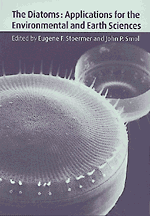Book contents
- Frontmatter
- Contents
- Contributors
- Preface
- Part I Introduction
- Part II Diatoms as indicators of environmental change in flowing waters and lakes
- Part III Diatoms as indicators in extreme environments
- Part IV Diatoms as indicators in marine and estuarine environments
- Part V Other applications
- 18 Diatoms and archeology
- 19 Diatoms in oil and gas exploration
- 20 Forensic science and diatoms
- 21 Toxic and harmful marine diatoms
- 22 Diatoms as markers of atmospheric transport
- 23 Diatomite
- Part VI Conclusions
- Glossary, and acronyms
- Index
22 - Diatoms as markers of atmospheric transport
Published online by Cambridge University Press: 16 January 2010
- Frontmatter
- Contents
- Contributors
- Preface
- Part I Introduction
- Part II Diatoms as indicators of environmental change in flowing waters and lakes
- Part III Diatoms as indicators in extreme environments
- Part IV Diatoms as indicators in marine and estuarine environments
- Part V Other applications
- 18 Diatoms and archeology
- 19 Diatoms in oil and gas exploration
- 20 Forensic science and diatoms
- 21 Toxic and harmful marine diatoms
- 22 Diatoms as markers of atmospheric transport
- 23 Diatomite
- Part VI Conclusions
- Glossary, and acronyms
- Index
Summary
Introduction
In 1846 Charles Darwin wrote:
‘On the 16th of January (1833), when the Beagle was ten miles off the N. W. end of St. Jago (Cape Verde Islands), some very fine dust was found adhering to the under side of the horizontal wind-vane at the mast-head; it appeared to have been filtered by the gauze from the air as the ship lay inclined to the wind. The wind had been for twenty-four hours previously E. N. E., and hence, from the position of the ship, the dust probably came from the coast of Africa’.
Darwin sent some of this dust to Ehrenberg (1844) who found diatoms. Windblown material is widespread (Pye, 1987) and the study of aeolian diatoms can indicate past changes in atmospheric circulation. The most abundant aeolian diatoms are freshwater ones blown from North Africa into the intertropical Atlantic, where they often outnumber the marine ones (Pokras & Mix, 1985).
Most diatoms grow in water bodies where the surface tension film protects them from light winds. Stronger winds pick up water and diatoms which can act as nuclei for raindrops and so often drop out. Schlichting (1964) trapped more soil algae from updrafts on cloudy days; but he caught few live diatoms. Marshall and Chalmers (1997) only trapped broken cells of Pinnularia borealis Ehrenberg; when alive these motile diatoms avoid dry surfaces. Diatom remains from dry fossil deposits and algal flakes from dried-up water bodies are more readily picked up by the wind.
- Type
- Chapter
- Information
- The DiatomsApplications for the Environmental and Earth Sciences, pp. 429 - 435Publisher: Cambridge University PressPrint publication year: 1999
- 8
- Cited by



